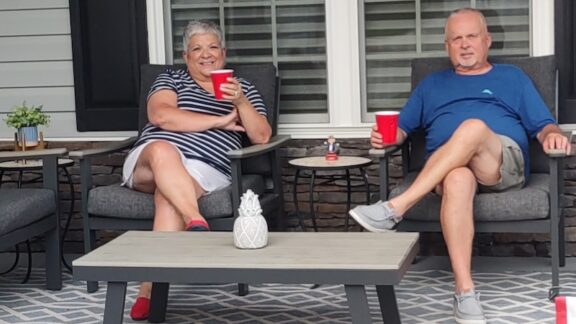A cohousing community for seniors provides an option between aging in place at a longtime home and moving to a retirement community. Seniors Guide writer Terri L. Jones examines this possibility.
If you’re like most seniors, your goal is to live in your own home for as long as possible, or aging in place. However, at some point, you’ll inevitably need some help – whether it’s just someone to walk your dog or pick up groceries now and then or something more involved like sitting with you after a hospital stay. But if you don’t have family or anyone else nearby to lend a hand, aging in place can be challenging. Cohousing, a relatively new concept in the U.S., can provide both the independence you want with the interdependence you may need down the road. Some refer to this solution as “aging in community.”
What is cohousing?
First of all, a cohousing community is not a commune, a co-op, or even co-living. According to the Cohousing Association of the United States, cohousing is an intentional, collaborative community, where residents own (in some cases, rent) their own homes but share common indoor and outdoor areas where they enjoy meals, play games, work out, learn, and celebrate with their neighbors. While homes in these communities tend to be on the smaller side, including single-family, condos, townhouses, tiny houses, or even retrofitted motels or office buildings, residents’ living space doesn’t end at their property line but extends to common houses and other shared spaces.
Residents pitch in to help their neighbors with various tasks but also contribute to the community at large with landscaping, cooking, managing budgets, maintenance, and other work. (While some community work may be contracted out, the goal is for residents to do as much as possible to save costs and create connection.) By sharing time, skills, and other resources as well as designing for lower energy use, these communities have less impact on the environment.
Cohousing communities are usually smaller than most traditional developments, averaging between 20 and 40 households. Many charge community fees, much like homeowners association dues, and they’re designed, governed, and run by the residents themselves.
Seniors can choose a multigenerational community, for the energy and enrichment of living among diverse age groups, or one restricted to people 55 and older (known as senior cohousing communities or SCCs). After living in cohousing, residents often consider these communities an extended family, whatever the ages.
The foundation of cohousing
Cohousing’s primary objective is connection, creating close-knit communities that work together and support one another. To achieve that goal, these communities seek residents who have similar values, lifestyles, and goals. While most cohousing communities promote environmental sustainability, others may also be built upon values like social justice or spirituality. One women-only community of tiny houses and RVs in Texas only accepts female residents over 55 who like animals (the 11 women in the community have nine dogs and four cats among them), and who dislike “drama.”
This symbiotic lifestyle goes a long way in preventing isolation and loneliness, which is a real risk for seniors who live alone. When 72-year-old Angela Maddamma lived in a suburban development, her neighbors were simply acquaintances that she waved to each day. She had to venture outside her neighborhood to find actual friends. “I realized that I spent a good part of my adult life searching for community,” she told The Guardian.
The day she moved into a senior cohousing community in Virginia, Maddamma was thrilled to be welcomed by a group of neighbors who brought her dinner. And the stream of new friends continued until she switched off her porch light (communities have a code to communicate when you want to socialize and when you don’t).
Where it all started
Cohousing originated in Denmark in the early ’70s and is still very popular there. In fact, a recent survey found that 80,000 Danish seniors would like to move into cohousing within the next five years, but there aren’t enough homes to go around.
It wasn’t until the early ’90s that this collaborative housing model made it to the U.S. Senior cohousing communities started popping up about two decades later. Currently, there are hundreds of multigenerational communities across the country, according to the Cohousing Association of the United States, with only 17 communities designed for seniors (10 more SCCs are in development).
While the current number of senior cohousing communities in this country is low, it’s rising quickly since seniors find the mutual support so appealing, Dr. Angela Sanguinetti, director of the Cohousing Research Network, told Mutual of Omaha. “You see your neighbors regularly and know who is coming and going,” she explains, adding, “Just as important is noticing when a neighbor you normally interact with is suddenly not around. They might need to be checked on.”
10 Senior Living Trends That Put People First
What’s to love about a cohousing community for seniors
Two academic social workers and gerontologists delved into the subject of a cohousing community for seniors and how these communities promote health and wellbeing among older adults. In their research reported on BlueZones.com, they noted that what the residents of these communities enjoy the most is the social engagement, including shared meals, parties, and discussion groups, as well as the opportunity for spontaneous interactions. Plus, the support that community members received after major life events, like the loss of a spouse or even for small tasks, was invaluable. This supportive relationship also made the neighbor providing the support feel needed, which is critical as seniors age.
“These are people you know and care about,” 63-year-old Gretchen Brauer-Rieke, who lives with her husband in an Oregon senior cohousing community, reported to Mutual of Omaha. “We all understand that the more we put into this, the more we get out.”
Although it seems counterintuitive, the researchers discovered that many residents of these communities, which are built on engagement and connection, are introverts. Explained one cohousing resident on BlueZones.com, “For introverts it’s perfect, because you go in your house and you can be in there as much as you want, but when you come out, you don’t even have to go make friends somewhere.”
Cohousing communities are especially ideal for introvert-extrovert couples. The extrovert can go out into the community and socialize to their heart’s content while the introvert can enjoy alone time.
 Cohousing residents also found eating together to be the cornerstone of these communities. Opportunities range from casual meals with one or a few neighbors to the communal meals open to all residents (regular attendance is recommended but not mandatory). This ritual goes way beyond simply sharing food; it’s a bonding experience for residents and integral to making this housing choice effective and sustainable.
Cohousing residents also found eating together to be the cornerstone of these communities. Opportunities range from casual meals with one or a few neighbors to the communal meals open to all residents (regular attendance is recommended but not mandatory). This ritual goes way beyond simply sharing food; it’s a bonding experience for residents and integral to making this housing choice effective and sustainable.
Residents not only share meals, time, and assistance but also possessions like lawn mowers, grills, power tools, and even cars. As a result, they’re able to save money because they don’t have to purchase as much “stuff” and can live in smaller homes.
Another benefit is that most cohousing communities are governed by all the residents, with no one person or persons having authority over everyone else as in typical HOAs. Consensus as opposed to majority voting is used to make decisions.
Safety is also a perk of cohousing communities. Because neighbors live in close proximity to one another and look out for each other, “this shared responsibility makes everyone feel secure, knowing that their neighbors are always ready to step in if something seems amiss,” notes one Colorado cohousing community website. In addition, most communities require that cars are parked on the perimeter, eliminating traffic to contend with and making the neighborhood more pedestrian-friendly.
What’s not to love
While some people love the frequent socializing of cohousing, others find it to be invasive and overwhelming. In a community with so much togetherness, some residents miss the privacy and anonymity of a traditional housing development. And if some of the residents tend to be Negative Nellys or contrarians, this togetherness can be especially exhausting. It can also make consensus decision-making, which is a positive on one hand, contentious and protracted on the other. In the case of the women-only community in Texas, there was disagreement over whether cats were allowed to roam and men were allowed to spend the night. Eventually, neither cats nor men achieved a consensus.
Let’s not overlook the amount of work required. Every member must contribute a certain number of hours on a regular basis to the operation of the community. This includes serving on committees, cooking and cleaning up communal meals, groundskeeping, repairs, and, in multigenerational communities, childcare.
On Cohousing.org, a resident of a Washington, D.C. community wrote about the necessity of participation: “From the first thought of really living in cohousing, an essential requirement is being able to depend on each other to share the work. It’s a collaborative effort and requires all hands on deck.” She went on to explain what a struggle it was to get all residents to participate.
Benefits of an Independent Living Community
Do your homework
Cohousing communities can be the perfect fit for seniors who need and want socialization and engagement in their lives – or in other words, a sense of community. But they’re not right for everyone. Before you head down this road, visit a variety of communities, if possible, to experience the dynamics between the residents and the culture of the community. Ask if you can participate in community meals and workdays. Chat with the people who live there. You might also want to investigate communities that are just forming to be able to have a say in the design and get in on the ground floor. You can find communities on the Cohousing Association of the United States website.
It takes a village … and that goes for your senior years, too. A cohousing community could be the village you need to get the most out of this stage of your life!





